What a delight the past month has been here in Ann Arbor! Lots of sunny days with enough rain to keep the gardens green and growing, cool nights and pleasant days, perfect weather, in short, for being outdoors planting, weeding, pruning, staking…as well as enjoying the scents and beauty of the iris, peonies, lilacs and early roses! It has been, as always, a delight to see the sprouts of dahlias come poking above ground, spreading their eager leaves to take in the sunshine, and to anticipate the blossoms that will come later in the summer. While some bulbs like rain lilies and surprise lilies may not yet have made an appearance, we hope your garden is off to a great start as well! If you’ve encountered difficulties, do let us know so we can try to discern what may have gone wrong.
Tips for Making Your Peonies in Bouquets Last Longer
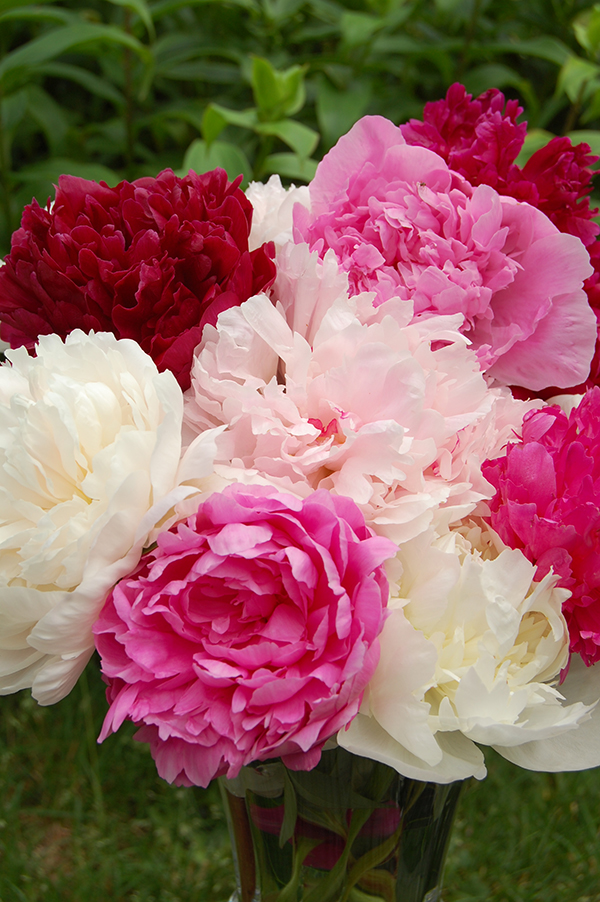
Lush and romantic, peonies are fabulous in bouquets. To get the most out of yours, here are some tips from Dr. Patricia Holloway of the University of Alaska, as quoted by Debra Prinzing in her book Slow Flowers:
“‘Cut peonies during the coolest part of the day. Cut once you see the true color of the flower with one or two petals separating at the top [the “soft marshmallow” stage] – or any time after that. Then the flower will continue to open in your arrangement.’ If you cut prior to this stage the buds either will not open or they will be stunted. Fully-opened blooms can also be harvested, but their vase life is shorter. . . .
“Dr. Holloway also offers this commercial growers’ tip; ‘Once cut, your flowers should be chilled in the refrigerator for at least 24 hours and up to one week before putting them into a vase. That chilling very definitely extends vase life.’ Wrap the peonies in paper towels and lay them flat in the crisper drawer, away from the refrigerator’s other contents.”
We’ll also remind you that for future growth and bloom it’s best to leave as much foliage as possible on the plant. This is especially important during the first two years after planting, and in fact many experts recommend that you cut NO flowers the first year. We know how hard that can be, but your patience will be rewarded.
Dividing Your Dahlias? We’d Love to Know if You Have Preserved These Treasures!
Our experience with the Historical Iris Preservation Society last year as they collected varieties lost in Holland but still grown in American gardens inspired us to check our own lists of varieties we can no longer find. Sometimes a small-scale grower retires unexpectedly due to illness; sometimes varieties are lost due to unlucky weather events (last spring our New Hampshire friends had their fields flooded late into planting season, resulting in poor harvests in the fall), or there may be an issue with storage conditions over the winter. We’d like to resurrect some of these “lost treasures” and spread them to more gardens before they’re gone forever, so If you have any of these varieties to share, please let us know. We - and the dahlia lovers who have been wishing for their return - will be thrilled.
Check Out Our Summer and Fall Offerings Too, Now Including ‘Coral Sunset’ Peonies
We’re awaiting our peonies blooming in a few weeks and are excited to be able to offer a variety in glowing colors seldom seen in the peony garden: deep coral-peaches softening into salmon and then ivory. Illinois hybridizer Samuel Wissing spent over 25 years developing his famous coral peonies and this APS Gold Medal winner, turning 60 next year, is one of his best. David Michener raves “The changing color tones flow so well that it is a delight to behold…Would that even a handful of summer sunsets were equal to this peony’s bloom.” If you love warm colors, particularly in soft cups full of golden stamens, this is a peony sure to delight you.
And before your memories of your daffodils, tulips and crocus from this spring fade, give some thought to whether there were particular varieties or colors that you wanted to increase next fall (or to try for the first time) in any gaps you noticed in your springtime displays. It’s a good idea to mark the location you use for planting next fall with an interesting stone, a labeled stake, or even a handful of the colored gravel sold for use in fish tanks. If your beds or borders are anything like ours, they fill in so well over summer that what seemed obvious last month can be unrecognizable in October.
Last Call for Spring Orders! And Thanks for Your Support!
Woo hoo! The weather is glorious here, tulips are blooming, iris and peonies are budding, and the birds are singing. It’s been a great season (thank you!), Rita’s about to go on vacation in Croatia (!) and we’ve got lots of work awaiting us out in our gardens and production fields, so we’ll only be taking spring orders today and tomorrow (May 6 - May 7). Orders will ship out Wednesday and Thursday, so perhaps a mother or grandmother in your life would like a surprise next week! You can check our list of remaining bulbs, all now on sale at 30% off - here. And we’ll let you know later this year when we have varieties up online for spring 2025 planting!
Tips from Paul Siskind to Deter Scarlet Lily Beetles
These shiny red beetles (also known as lily leaf beetles, Liliocerus lilii) is a destructive Eurasian species that has been spreading across New England and the midwest since the 1990s. Both adults and larvae feed on the leaves, stems and flowers of native and hybrid lilies and can completely defoliate a plant if left unchecked. As our lilies break dormancy and send up their tender shoots here in Michigan we realized it’s time to start considering controlling them now. Adult beetles overwinter in the soil or leaf litter, emerge in spring and start laying eggs on iris leaves right away, so early detection is important. Our local extension bulletin has pictures of the adult, eggs and (disgusting) larvae to help you recognize them. Handpicking is a great place to start; the beetles are very sensitive to motion, so it’s helpful to hold a jar of soapy water under the leaf as you reach in to try to catch and crush them. Check your lilies daily early in the season for best control; if you can keep the population at a low level you can check less often in the summer.

If that’s not enough, however, we found Paul Siskind’s article in the North American Lily Society bulletin helpful as he shared his investigations into other relatively ‘natural’ or ‘environmentally friendly’ methods of control. He found that dusting with diatomaceous earth isn’t particularly effective, though it’s also unlikely to harm beneficial insects. Deer or rabbit repellents only had some effectiveness if they contained clove oil. But “if you have a moderate-severe infestation, the ‘safest” and most effective insecticide is spinosad because it kills both the beetles and the larvae. Compared with many other broad-spectrum insecticides, spinosad is safer because it doesn’t get absorbed into the plant and spread systematically into the plant’s fluids or pollen; rather, it remains of the leaf surface, where it kills the beetles/larvae by both contact and via ingestion.” Of course, read and follow all directions on the label, and avoid spraying blossoms or when wind interferes with targeted application onto just the lily leaves.
Along with this, Paul recommends alternating a spinosad spray with neem oil, which, though it only kills larvae, helps to prevent the development resistance to spinosad. The active ingredient in Neem that kills this species’ larvae is azadirachtin which, unfortunately, is removed in neem oils made through alcohol extraction, often found in products labeled as containing “clarified hydrophobic extracts of neem”. Look for “cold-pressed neem oil”, sometimes listed as “pure” neem oil. As far as timing, he says “At the beginning of the season (as soon as the lilies start to sprout), try to spray the lilies twice a week with spinosad. When you start seeing larvae, switch to neem once a week and spinosad once a week. On the days without spraying, do your usual hand-picking of beetles and larvae.” Once the egg-laying season has ended (about 4-6 weeks), you should see a decline in beetles and larvae and be able to cut back to using just spinosad once a week while still hand-picking.
Is it worth it? Native lilies are highly attractive to the beetles, so by reducing them in gardens, we can protect other species in the wild. Daylilies are not affected by these beetles, and both Lilium speciousum rubrum ‘Uchida’ and Lilium ‘Black Beauty’ have been observed to be less attractive to - and less damaged by - the beetles than Asiatic or other Oriental varieties. And lilies are beautiful and often fragrant, so for many, the answer is yes - as Paul says, “It might take a full season (or two) to get a bad infestation under control, but once it’s under control, it’s not difficult to incorporate this method into your normal gardening routine.”
Vanessa and Stephen Orr Talk Hyacinths in March’s issue of Better Homes and Gardens

We were delighted to hear from a number of you ordering for the first time last month that you’d found out about us from reading the article “5 Facts About Hyacinths That Will Make You Want to Plant Your Own” – and you weren’t just inspired to order hyacinths, but daffodils, daylilies, dahlias, peonies, and lots more! We especially loved Stephen’s beautiful photographs illustrating the splendid diversity of hyacinth colors, and Vanessa explained why hyacinths have become one of the most commercially-endangered types of bulbs, dropping, as Stephen says, from there being over 2,000 hybrids in the early 1700s to “now you might only find a handful in most catalogs.” We’re so glad to hear that Stephen (who is the editor in chief of BH&G), who’d avoided them for his own garden, tried more than a dozen varieties last year and now delights in their fragrance, spectrum of colors, historic importance and value as a nectar source for pollinators in early spring. We think all of you planting them for the first time this fall will be equally enchanted come next spring!
“Look Whose Dahlias Took the Blue Ribbon at the Topsfield Fair!”
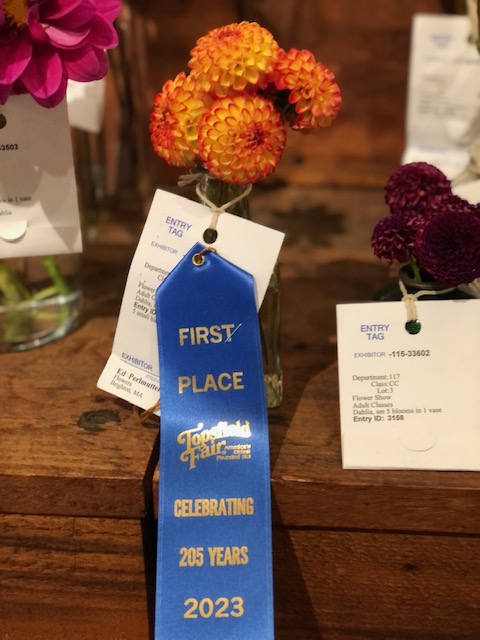

We were thrilled last fall to have our good customer Ed Perlmutter write “Wow – was I ever excited when I found a First Place Blue Ribbon slapped on my entry of five small dahlias Friday afternoon at the Topsfield Fair (the oldest agricultural fair in the country). I’m pretty sure it’s Kaiser Wilhelm — the colors are just stupendous*. couldn’t have done it without Old House (and my special sauce fertilizer 😉). It’s been a stunning year. Thank you for all the great years of dahlias (this is my fourth blue ribbon at Topsfield since 2010).”
Congratulations, Ed, thanks for sharing your good news, kind words, and your great photos!
OHG Helps HIPS in International Iris Repatriation Exchange
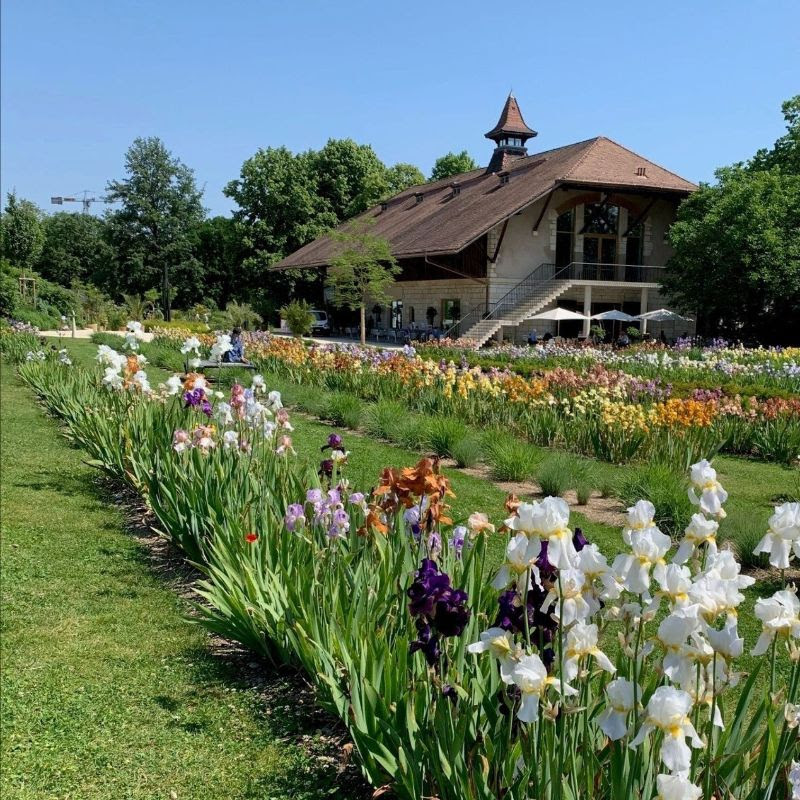
Back in the summer of 2021 the Historic Iris Preservation Society sent 26 rare varieties of heirloom iris plants to Merian Gärten of Basel, Switzerland which had disappeared from European gardens over the past century. They hold the largest bearded iris collection open to the public in Europe, preserving around 1500 varieties of tall and medium bearded iris (the type found in most gardens) and close to 100 different wild or species iris. Many of the varieties were developed before the middle of the last century and the Merian Gardens keeps them from disappearing altogether since many are no longer commercially available. We loved the idea of supporting their efforts and contributed ‘Plumeri’ (1888), a fragrant little iris whose jewel-toned colors and early, abundant bloom have made it a long-time favorite of ours. Those, along with donations from other American gardens made up the initial shipment, and since then more varieties have been sent.
HIPS’ Guardian Gardens Network (which distributes heirloom varieties to be preserved in members gardens across the US) put together a wish list of varieties no longer found either in commerce or in American gardens, many of which were developed by American breeders over the past century. Happily, Merian Gardens were able to find many of them in their collection and sent several hundred plants to HIPS last fall! As Lisa Eggenschwiler and Barbara Wüthrich explain, “This is the first time for us to ship plants from our collection outside of Europe. So far, exchanges have been limited to the network with the EU, where the transfer of plant material between scientific institutions is easier. We are happy that we are part of an international network and in this way can contribute to the preservation of iris varieties worldwide with our collection.” The varieties they’ve given have now been distributed among a number of preservation Guardian Gardens across the US so that problems at one won’t mean the loss of all of the variety. It’s good to know there are so many people working to keep these heirloom treasures alive and available to future generations – and thanks to all of our customers who have been doing the same work in their own yards!
Spring Shipping Is Full-Speed-Ahead Now

We were able to begin shipping iris earlier than normal due to a warm March and our faithful crew of pickers and packers has been working since April 2 on the dahlias, gladiolus, and other orders. We hope to have the rest of the spring orders we have already received on their way to gardeners within the next two weeks and as always we’ll be sending an email notification when a shipment leaves here. We’ll continue taking new spring orders through the end of April, though don’t delay: varieties sell out every day, and some iris will soon be too big to ship (though you’ll have another chance in July.)
How Might This Winter’s Weather Affect Your Bulbs?
Warmer, colder, wetter, drier – weird weather seems to have been the norm this winter. Of course heirloom plants have survived by taking strange weather in stride, but here’s how it may affect your plants this spring.
WARMER? Mild winters allow the eggs of iris borers and spores of fungal diseases to over-winter more successfully, so it’s especially important to remove all of last year’s peony foliage and clean up around your iris before temperatures warm any further. If you mulched your peonies with straw or leaves last fall, loosen the mulch now and make sure it’s not starting to mold.
NO SNOW? Like a down comforter, snow traps air which makes it a great insulator. If your winter was short on snow, your bulbs and newly planted perennials such as peonies may have gotten a lot colder than usual, which could result in dead or weakened plants this spring.
Snow also protects the soil from the freeze-thaw cycle that occurs when sunny days are followed by much colder nights. Freezing and thawing can break bulb roots and heave newly planted perennials out of the ground. Check now and re-set any plant that’s been heaved, putting a brick or rock on either side to anchor it. In colder zones you might even want to add a light straw mulch now to protect your plants through the last weeks of winter when the freeze-thaw cycle is often at its worst.
When snow melts, it recharges soil moisture which is especially important to the mad rush of spring growth. If snowfall was skimpy in your area, water your bulbs and perennials as soon as they emerge this spring instead of waiting till later on.
MORE RAIN? If your winter – or fall – was wetter than usual, that may lead to better bloom on your daffodils this spring, but it could be hard on other bulbs. The freeze-thaw cycle is most damaging in water-logged soils, and some bulbs such as crocosmia always do best in very well-drained winter soils. Soggy soils are never good for iris or peonies, so if water puddles around yours this spring, drain it away to avoid rot.
DROUGHT? Bulbs are built to conserve moisture during dry periods and often bounce back after a drought better than most plants, although it may take a while for them to recover completely. Some bulbs like tulips and hyacinths actually bloom better after a dry summer, but even they will suffer without good moisture through fall and winter.
No matter how weird your winter was, paying attention to how your plants respond will make you a better gardener. And try not to worry. Most of the time, most plants will be just fine – and on the bright side, dead plants give you more room for new ones!
Dahlia Growing 101: Let’s Talk Heirloom Tubers!
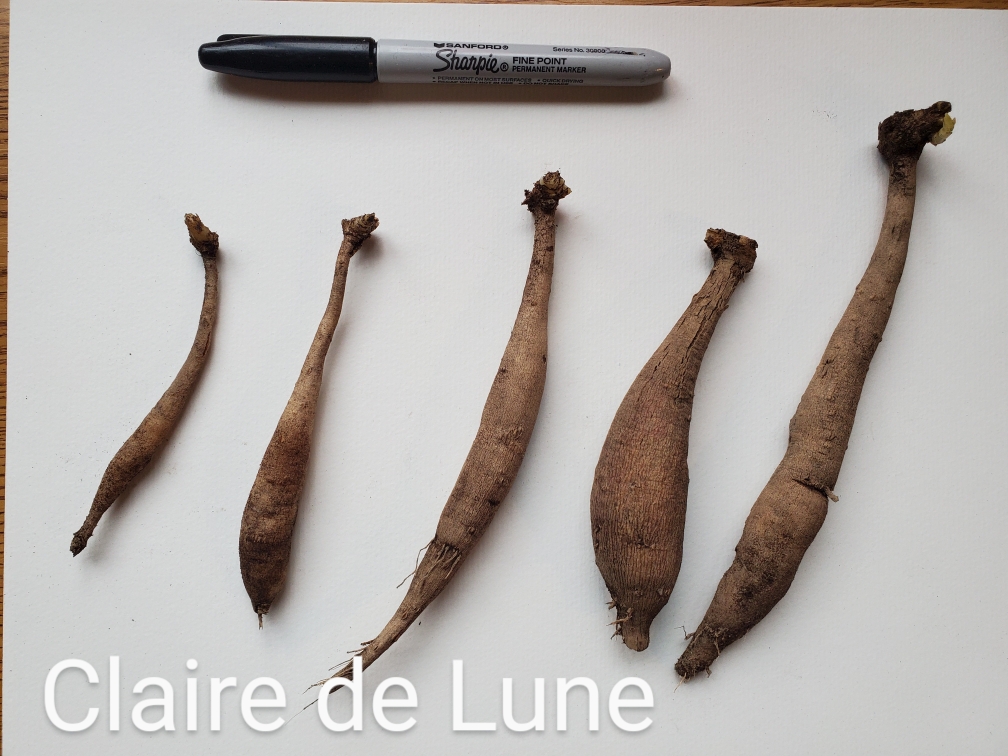
As you may have guessed, we love growing dahlias for their diverse colors and forms and the way they close the gardening season with beauty and abundance, and we want to share some of our experiences and observations with those of you who may be trying them for the first time. Unlike the bulbs you may be used to from tulips or daffodils which have a standard or regular form, dahlia tubers - and especially heirloom dahlia tubers - can come in a wide array of shapes, sizes, and forms. Depending both on what variety they are and on how they were grown, tubers may be like golf balls, compact and rounded, or like enlarged string-beans, long and skinny, sometimes curved, sometimes straight, and anything in between. We examine each tuber and only send ones that we expect will grow and bloom well for you, so don’t be alarmed by their size or shape on arrival.
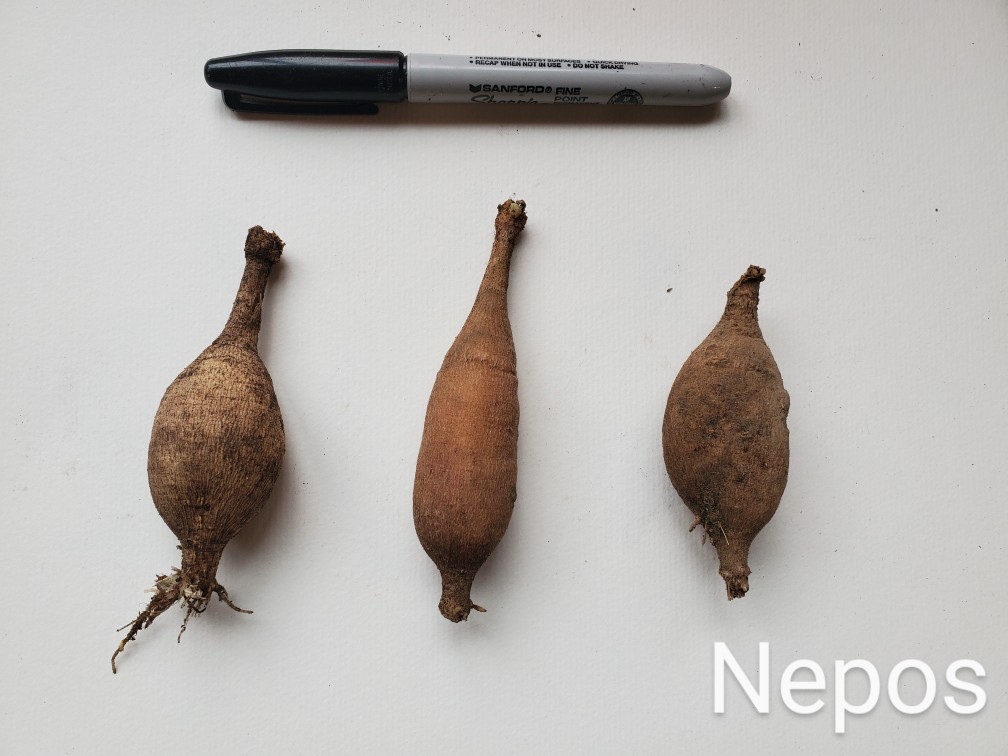
Some varieties like ‘Lutt Wichen’, ‘Claire de Lune’ and ‘Union Jack’ tend to be “shy” producers of tubers, with fewer or smaller daughter tubers, and these are often the ones that drop out of mainstream commerce. At Old House Gardens we try to keep such historic varieties from disappearing altogether, even if it means that you are more likely to start with a small tuber than when you buy a modern variety. But please don’t worry that it won’t grow well just because it’s small. The tuber only has to provide enough energy and nutrients to enable the plant to put down roots, send up its first leaves, and start to fend for itself, so (like flower seeds) a small tuber can produce a large plant. We (and our customers) have found that tubers with the volume of our little fingers (or a triple-A battery) are big enough to get plants off to a good start.
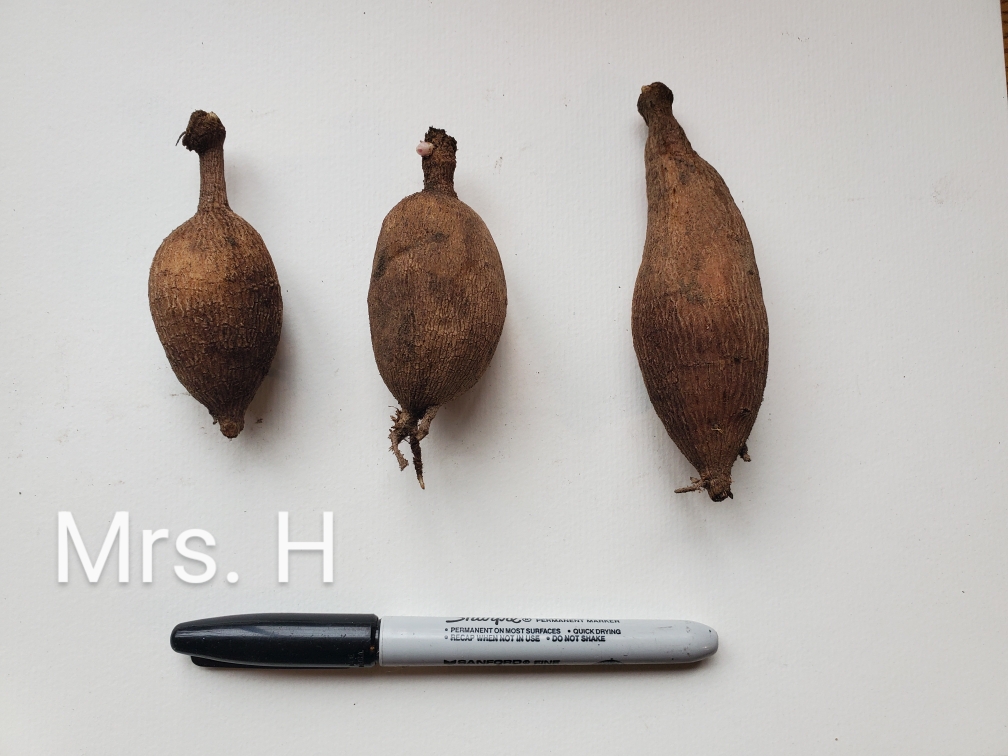
Other variability comes from how the dahlia was propagated. Large-scale growers in the Netherlands use “pot-culture” which produces scruffy clusters of tubers, sometimes with necks that have been broken as they were washed or handled. You only need one to grow, so many people just cut off the ones that are dangling by a thread or two and only plant the remainder. On the positive side, these are often more affordable since they’re grown in higher volume. Small-scale growers (like ourselves and our American partners) typically dig and divide their dahlia clumps by hand, resulting in neatly trimmed and tidy single tubers instead of a cluster. These too will do well: again, you only need one tuber with an eye to have a full-sized plant come August, and planting a single tuber rather than a clump means that there is no competition for resources that might lead to fewer blossoms.
So don’t be alarmed by the range of shapes and sizes of your dahlia tubers on arrival! Plant and care for them as recommended in the accompanying instructions (or here) and they should thrive for you. Let us know if you have any concerns during the growing season so we can trouble-shoot what might be happening. We’re here to answer your questions and help ensure your success.
Pantone Color Institute Chooses “Peach Fuzz” for 2024’s Color of the Year

hyacinth

daffodil

tulip

dahlia

daylily
We always enjoy seeing what color is predicted to be trending each year and think this year’s color is especially lovely. Executive Director Leatrice Eiseman explains, “In seeking a hue that echoes our innate yearning for closeness and connection, we chose a color radiant with warmth and modern elegance. A shade that resonates with compassion [and] offers a tactile embrace.” There’s no need to redo your wardrobe or repaint your walls to enjoy it, though, since gardeners of the past have already handed down varieties that will fill your garden and vases with storied histories along with this year’s color. You may already have them growing, if you chose fragrant ‘Gypsy Queen’ hyacinths, delightful ‘Romance’ daffodils, or glowing ‘Apricot Beauty’ tulips. Or add them to your summer garden palette with customer-favorite ‘Preference’ dahlias or refreshing ‘Melonee’ daylilies. And we’re thinking about sipping peach margaritas as we relax in our garden oases – 2024’s going to be a great year!
And Be Sure to Check Out These Two Fall-Blooming Crocus!


We’re excited to have these unusual crocus varieties to offer for the first time. They need to be planted early in the fall for first-year bloom, so it’s best to order early. Crocus speciosus ‘Conqueror’ has glowing violet-blue blossoms with bright orange centers that brighten autumn beds just as most plants are going dormant, often sending up flowers before their leaves emerge fully. And Crocus sativus, the saffron crocus, has been cultivated for millenia around the Mediterranean for their red-orange pistils which are used as a prized seasoning. The flowers are shades of lilac to purple flowers, and while it can take over 4000 blossoms to produce an ounce of saffron, it’s fun to grow some of your very own!
Spring Shipping Begins Soon
We’ve had surprisingly mild weather here in Michigan the past couple of weeks and expect to begin shipping by Monday April 1. Of course, Mother Nature’s in charge since we don’t want freezing temperatures to harm the bulbs on their way to you! We’ll send you an email with tracking information when your order leaves here, so you’ll have an idea of when it will arrive.
But don’t fear: you still have time to order our fabulous heirlooms for spring planting, so whether you’re just anticipating or in the midst of spring where you are, take a virtual stroll through our rare and beautiful spring-blooming heirlooms and find the ones that most delight you. Please have any changes or additions to existing orders to us as soon as possible since once shipping begins it is usually too late to make adjustments to them.















